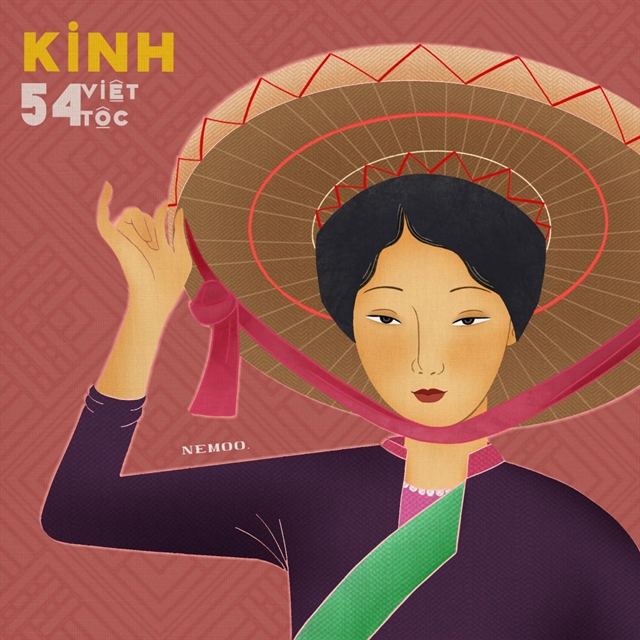 Features
Features

The Chàm Islands off the coast of central Việt Nam have found success in managing the sustainable catching of land crabs.
By Công Thành
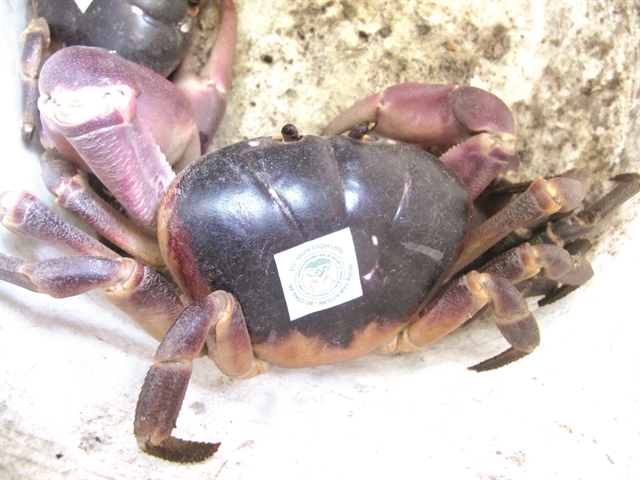
|
| Land crab (Gecarcoidea lalandii) – a purple shelled crustacean – is sealed for sale at the Chàm Islands, off the coast of Hội An. The crab has been built as an eco-tour product and sustainable development of the Chàm Islands in boosting eco-tour service. VNS Photo Công Thành |
It’s sunrise on the Chàm Islands. Members of the local land crab co-operative rush home with baskets full of crabs after a night hunting in the hilly forest. The catch is reported to the co-operative management board before their shell size is measured and, if they meet the criteria, a label attached denoting they are for legal sale at the market.
Nguyễn Duy Khanh, 38, head of the co-operative, is waiting for the hunters to return to the co-operative centre, where he will check the catch. Only crabs with a shell at least 7cm long will head to the market.
“It’s a strictly-enforced rule aimed at ensuring the sustainable protection and conservation of land crabs,” he explains. “Labels are only attached on crabs that meet the criteria for sale, while pregnant or smaller crabs are released back into the forest.”
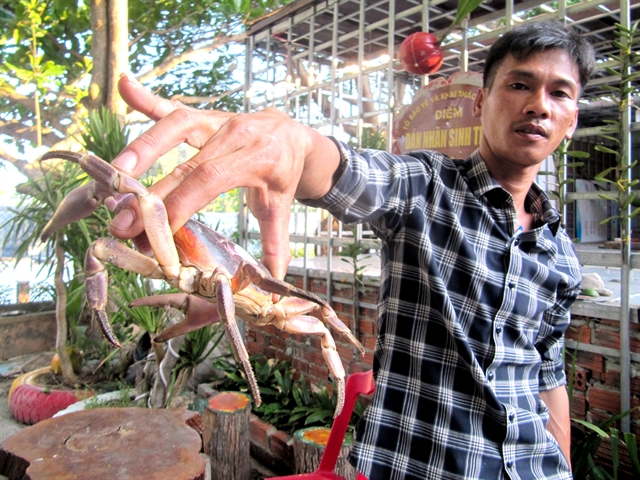
|
| Nguyễn Duy Khanh, head of the Chàm Islands crab co-operative, checks a land crab from forest. Only adult crab is sealed with eco-label stamp for legal sale at the islands. The strict control of crab hunting helps protect the crab species, while improving the local islanders income. VNS Photo Công Thành |
“Each member of the co-operative is permitted to catch only 50 crabs, or 8kg, each season, which lasts from March to late July,” he says.
Khanh says the co-operative was established to ensure the community-based management and exploitation of the natural resource, helping islanders increase their earnings while protecting the natural environment.
The co-operative and its 42 members also work to ensure harmony between people and nature, and only members are permitted to catch crab in the forest.
Catching rules
Land crabs (Gecarcoidea lalandii) - purple shelled crustaceans - have become an eco-tour product that will support the sustainable development of the Chàm Islands.
Twenty kilometres off the coast of central Việt Nam’s Hội An ancient town, a world biosphere reserve, the islands are the only place in the country to have successfully monitored and managed wild crab catching.
Visitors will be unable to see any crabs at the local market during the reproduction season, between July and October, when all catching is banned, Khanh adds.
When in season, he explains, crab hunters head into the forest at 6pm and stay there overnight, with each kilo selling for VNĐ1.2 million (US$52), which is a handy sum when added to regular incomes from fishing and tourism services like driving motorbike taxis or boats, guiding tours, and diving.
“The 25 members of the co-operative have benefited from zero interest loans of VNĐ150 million (US$6,500) from the Global Environment Facility (GEF), to support the sustainable protection and conservation of land crab species,” Khanh says.
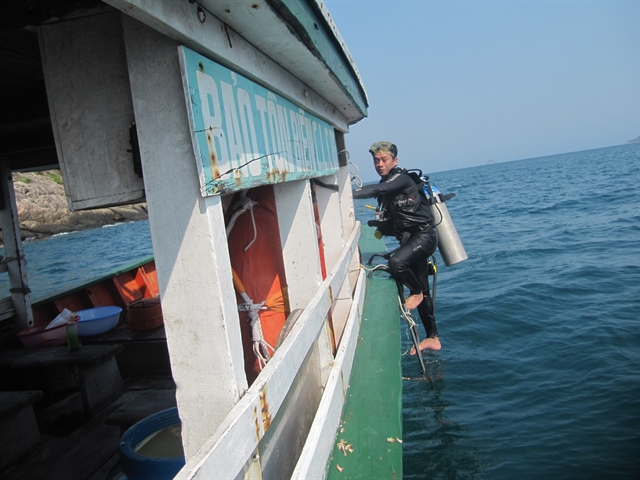
|
| Scuba diving in the water off Chàm Islands. The world biosphere reserve site has been built as the first eco zone in Việt Nam -- where conservation and sustainable development is top priority. VNS Photo Công Thành |
The fund encourages members to strictly follow the “no crab catching” ban in place between August and February.
According to experts from the Chàm Islands Marine Protected Area (MPA), each purple-shelled crab produces as many as 27,000 offspring each year, but only 3 per cent survive. Mother crabs often move from the forest to the sea for seven days to lay eggs. Baby crabs must then seek a way back to the forest, and the females among them will reproduce 16 years later.
Khanh says an adult crab, with a shell size from 7cm to 12cm, needs these 16 years to fully grow in an area of the forest with abundant food sources.
Biodiversity Dr Chu Mạnh Trinh from the Chàm Islands MPA says the establishment of the co-operative has ended over-catching and illegal hunting of crabs.
“Only people with power can protect their natural surroundings,” he says. “Community-based management has generated success stories, and the Chàm Islands is a great example of sustainable development at work.
“Management has also helped boost the value of the islands’ crab ‘brand’ in recent decades, which benefits conservation efforts.”
The community has established a crab protection team, he says, which monitors over-catching and illegal hunting.
A report from the Chàm Islands MPA notes that about 7,000 crabs are caught each year and 75 per cent of the islands’ crab population are conserved.
Trinh explains that the sustainable exploitation of the crabs guarantees livelihood for islanders into the future, with all involved having a stake in reducing over-catching and mass exploitation.
The islands are the only place in Việt Nam with a “land crab bank” - a free crab-catching zone on Dài Islet, one of eight islets making up the Chàm Islands.
Nguyễn Văn Phong, a member of staff at the Chàm Islands MPA, says crab conservation is appealing to many tourists visiting the islands, along with a “Say No” to plastic bags campaign instituted in the community and among tourists since 2011.
Many islanders, he says, can earn more money from providing services such as homestays, motorbike rentals, boat trips to islets, diving, or trekking.
Trần Quý Tây from the Chàm Islands People’s Committee says at least 40 per cent of local people earn a living from tourism and not just fishing.
Life for the islanders was previously reliant upon fishing, Trinh says, but eco-tours and environmental protection have changed the islands’ economic structure towards sustainability.
Challenges to address
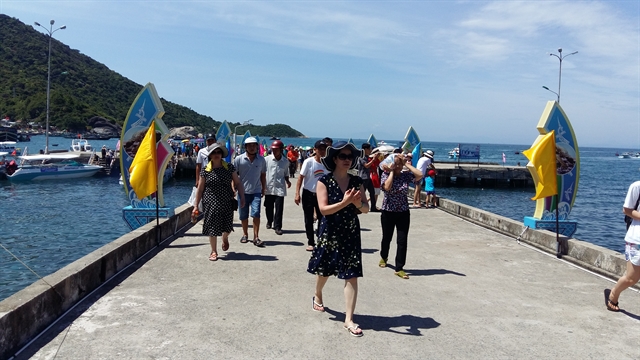
|
| Tourists visit Chàm Islands on boat trip from mainland Hội An City. The islands are seen as a favourite eco-tour site in Việt Nam for their pristine nature and well protected environment. VNS Photo Công Thành |
The director of the Chàm Islands-Hội An MPA Centre, Trần Thị Hồng Thúy, says mass tourism has come with major challenges for the islands as an excessive number of boat trips from the mainland will threaten its rich ecosystem.
The demand for seafood among increasing numbers of tourists will also lead to over-fishing offshore.
Thúy recalls that a large area of sea grass was destroyed between 2009 and 2018, while tourist numbers have increased by a factor of 20 since 2009.
She says about a hundred restaurants, shops, seafood agents, and homestay services have appeared on the islands, which combined with the building of road infrastructure have cleared 102ha of special use forest (out of a total 1,500ha of forested area) over the last decade.
The Chàm Islands-Hội An World Biosphere Reserve, which covers more than 33,000ha, was recognised by UNESCO in 2009. It has 1,500ha of tropical forests and 6,700ha of ocean area boasting a wide range of marine flora and fauna.
The islands are the only location in Việt Nam banning the use of plastic bags and promoting “3Rs” (reduce, reuse, and recycle) programmes, since 2011.
Khanh says each member of the co-operative can earn VNĐ25 million ($1,000) or more in total from crab hunting being strictly controlled.
The co-operative has also been farming mushrooms and other organic crops, he adds, creating more income-earning opportunities for members and easing over-exploitation of forests and oceans. VNS



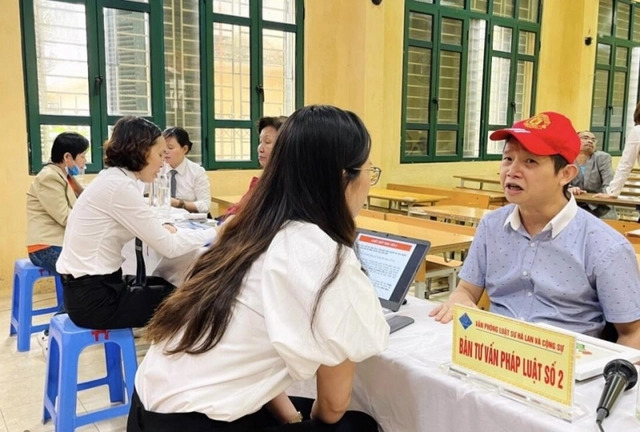
.jpg)